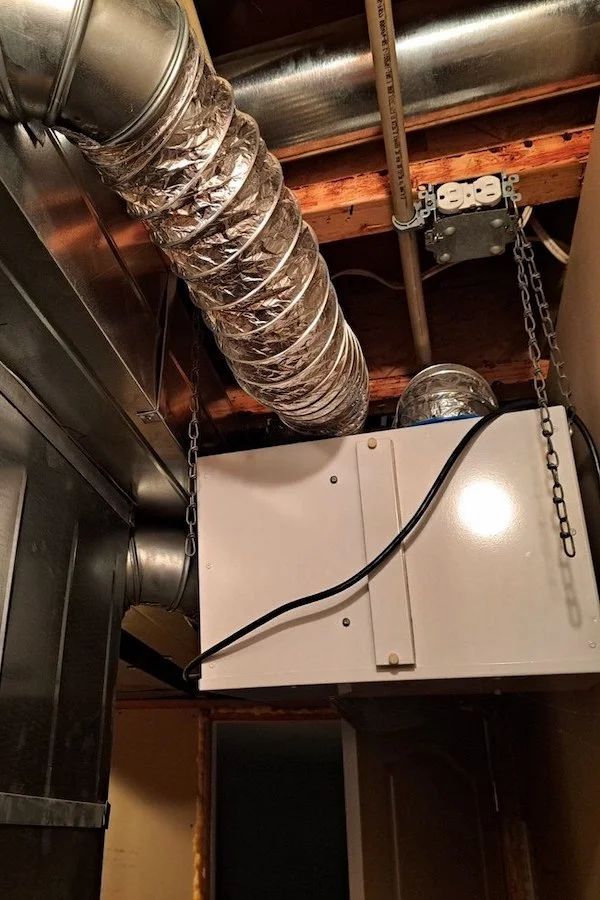What Is a Ductless Heat Pump?

Defining a Ductless Heat Pump

A ductless heat pump, also known as a mini-split system, is a heating and cooling solution that transfers heat between indoor and outdoor units without requiring ductwork, ideal for homes without existing ducts.
Unlike traditional HVAC systems, a ductless heat pump consists of an outdoor compressor unit and one or more indoor air handlers, providing targeted climate control in specific zones.
The versatility of a ductless heat pump makes it a popular choice for retrofitting older homes, additions, or spaces where ducted systems are impractical, especially in climates like Quebec’s.
How Does a Ductless Heat Pump Differ from Traditional Systems?

A ductless heat pump eliminates energy losses associated with ductwork, which can account for up to 30% of energy waste in traditional HVAC systems, improving efficiency.
By delivering air directly to rooms via wall-mounted units, a ductless heat pump allows precise temperature control in individual zones, unlike central systems that heat or cool entire homes.
In contrast to portable air conditioners or space heaters, a ductless heat pump provides both heating and cooling in one system, offering year-round comfort with lower operating costs.
Components and Operation
Key Components of a Ductless Heat Pump

The outdoor unit of a ductless heat pump houses the compressor and condenser, which manage the heat exchange process by compressing and circulating refrigerant.
Indoor air handlers, typically wall-mounted, distribute conditioned air directly into rooms, connected to the outdoor unit of the ductless heat pump via refrigerant lines.
A remote control or smart thermostat allows users to adjust settings for each indoor unit of the ductless heat pump, enabling customized comfort in different zones.
How It Works

In cooling mode, a ductless heat pump extracts heat from indoor air and releases it outside, using refrigerant to absorb and transfer thermal energy efficiently.
In heating mode, the ductless heat pump reverses the process, pulling heat from outdoor air—even in cold temperatures—and transferring it indoors to warm the space.
The inverter technology in modern ductless heat pumps adjusts compressor speed dynamically, maintaining consistent temperatures while reducing energy consumption by up to 40% compared to traditional systems.
- Ensure the ductless heat pump is sized correctly, typically 9,000-36,000 BTU, based on room size and insulation.
- Choose ENERGY STAR-certified models for rebates and optimal efficiency.
- Install indoor units high on walls for even air distribution in the ductless heat pump system.
- Regularly clean filters to maintain airflow and efficiency of the ductless heat pump.
- Consider multi-zone systems for larger homes to maximize the ductless heat pump’s flexibility.
Types of Ductless Heat Pumps

Single-zone ductless heat pumps feature one indoor unit connected to one outdoor unit, ideal for heating or cooling a single room or small apartment.
Multi-zone ductless heat pumps connect multiple indoor units to a single outdoor compressor, allowing different temperatures in various rooms for larger homes.
Ceiling cassette or floor-mounted ductless heat pumps offer alternative installation options for aesthetic or space-constrained areas, blending seamlessly into modern interiors.
Performance in Different Climates
Cold Climate Performance

Modern ductless heat pumps, such as those from Mitsubishi or Fujitsu, are designed to operate efficiently in temperatures as low as -25°C, making them suitable for Canadian winters.
The hyper-heat technology in a ductless heat pump ensures reliable heating by maintaining compressor performance in sub-zero conditions, reducing reliance on backup systems.
In winter, a ductless heat pump uses a defrost cycle to prevent ice buildup on the outdoor unit, ensuring consistent operation during snow or freezing rain.
Hot Climate Performance

In summer, a ductless heat pump efficiently removes heat and humidity from indoor spaces, providing cool, comfortable air with minimal energy use.
The dehumidification feature of a ductless heat pump helps maintain indoor air quality, reducing mold risk in humid climates like coastal regions.
High SEER ratings (20-30) in a ductless heat pump ensure excellent cooling efficiency, lowering electricity bills during hot summer months.
Benefits of Ductless Heat Pumps
Energy Efficiency and Cost Savings

A ductless heat pump can reduce energy costs by 25-50% compared to electric baseboard heaters, thanks to its high efficiency and zone-specific operation.
ENERGY STAR-certified ductless heat pumps qualify for rebates, such as up to $5,000 from Hydro-Quebec or $6,500 under the U.S. Inflation Reduction Act through 2025.
By avoiding duct-related energy losses, a ductless heat pump maximizes efficiency, making it an eco-friendly choice for sustainable homes.
Flexibility and Comfort

The zone control of a ductless heat pump allows different temperatures in each room, catering to individual preferences and reducing energy waste in unused spaces.
Quiet operation, often below 25 decibels for indoor units, makes a ductless heat pump ideal for bedrooms, offices, or other noise-sensitive areas.
The compact design of a ductless heat pump fits seamlessly into various home styles, offering aesthetic flexibility without bulky ductwork.
Installation and Maintenance
Professional Installation

Installing a ductless heat pump requires a certified technician to ensure proper placement of indoor and outdoor units, refrigerant line connections, and electrical setup.
Installation costs for a ductless heat pump range from $3,000 to $8,000 for a single-zone system, with multi-zone setups costing up to $15,000 depending on complexity.
Proper installation of a ductless heat pump ensures compliance with local codes and maximizes efficiency, avoiding issues like refrigerant leaks or poor airflow.
Maintenance Requirements

Clean the filters of a ductless heat pump every 1-2 months to maintain airflow and prevent dust buildup, which can reduce efficiency and air quality.
Inspect and clean the outdoor unit of a ductless heat pump regularly, removing snow, leaves, or debris to ensure unobstructed operation.
Schedule annual professional maintenance for a ductless heat pump to check refrigerant levels, electrical connections, and system performance, costing $100-$200 per visit.
Choosing the Right Ductless Heat Pump
Top Brands and Models

Mitsubishi’s ductless heat pump models, like the Hyper-Heat H2i, offer exceptional cold-climate performance with SEER ratings up to 30 and reliable heating down to -30°C.
Fujitsu’s Halcyon series, a leading ductless heat pump, provides quiet operation and smart controls, ideal for multi-zone setups in larger homes.
Daikin’s Aurora series, another top ductless heat pump, features high efficiency (up to 24 SEER) and advanced filtration for improved indoor air quality.
Selection Criteria
Choose a ductless heat pump with a capacity (BTU) matched to your room size—12,000 BTU for 500 sq ft, or 36,000 BTU for larger spaces—to ensure efficiency.
Look for models with high SEER (Seasonal Energy Efficiency Ratio) and HSPF (Heating Seasonal Performance Factor) ratings, ideally above 20 and 10, for a ductless heat pump.
Consider smart features, like Wi-Fi-enabled controls in a ductless heat pump, for remote operation and integration with home automation systems.
Cost and Incentives
Cost of a Ductless Heat Pump

A single-zone ductless heat pump costs $1,500-$4,000 for the unit, with total costs including installation ranging from $3,000 to $8,000 depending on the brand and region.
Multi-zone systems for a ductless heat pump can cost $10,000-$20,000, but energy savings and rebates often offset the initial investment within 5-7 years.
Maintenance costs for a ductless heat pump are low, with filter replacements and annual servicing totaling $200-$400 per year.
Available Incentives

In Canada, Hydro-Quebec offers up to $5,000 for installing an ENERGY STAR ductless heat pump, with additional provincial incentives in some regions.
In the U.S., federal tax credits through 2025 cover 30% of the cost of a ductless heat pump, up to $2,000, under the Inflation Reduction Act.
Local utility programs may provide additional rebates for a ductless heat pump, so check with your provider to maximize savings.
Limitations and Considerations
Potential Drawbacks

A ductless heat pump may require a backup heating system in extremely cold climates (below -25°C) for consistent performance during prolonged freezes.
The upfront cost of a ductless heat pump is higher than traditional heaters, though long-term energy savings and rebates often justify the investment.
Indoor units of a ductless heat pump may not blend aesthetically in some home designs, requiring careful placement for visual appeal.
Solutions and Mitigations

Choose a cold-climate ductless heat pump with hyper-heat technology to minimize the need for backup systems in harsh winters.
Explore financing options from retailers like Home Depot or manufacturers like Mitsubishi to make the ductless heat pump more affordable upfront.
Opt for ceiling cassette or concealed units for a ductless heat pump to maintain a sleek interior design while retaining functionality.
Conclusion: The Value of a Ductless Heat Pump
Why Choose a Ductless Heat Pump?

Understanding what is a ductless heat pump highlights its role as an efficient, flexible solution for heating and cooling without ductwork.
A ductless heat pump offers energy savings, zone-specific comfort, and environmental benefits, making it ideal for modern and older homes alike.
By selecting a high-quality ductless heat pump and maintaining it properly, you ensure long-term comfort and cost savings for your household.

Exploring Ductless Heat Pumps for Efficient Home Comfort +1 (819) 485 0516
What Is a Ductless Heat Pump?

Nous offrons des services complets de CVC à Gatineau, Québec, spécialisés dans le chauffage, la climatisation, les thermopompes et les échangeurs d’air pour des projets résidentiels et commerciaux. hvacgatineau@outlook.com


Contactez-nous
HVAC Gatineau Services de Chauffage, Climatisation et Ventilation
Si vous recherchez des solutions CVC de qualité près de chez vous, notre équipe d’experts chez HVAC Gatineau vous garantit des résultats durables pour l’installation, la réparation et l’entretien de systèmes de chauffage, climatisation, thermopompes et échangeurs d’air. Nous servons Gatineau, Hull, Aylmer, Buckingham, Masson-Angers et les environs. Contactez-nous pour un devis rapide sur vos besoins en CVC à Gatineau et dans les environs.

